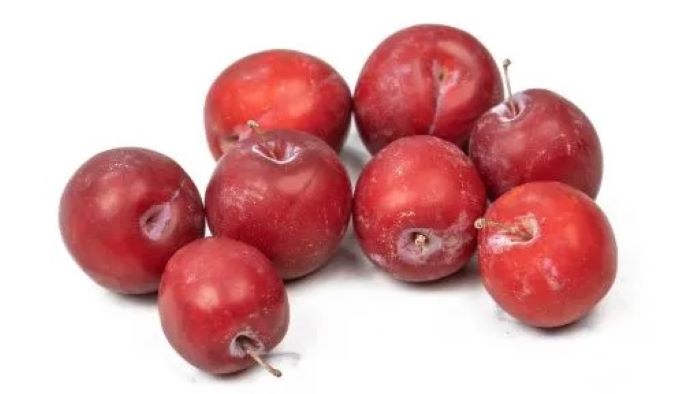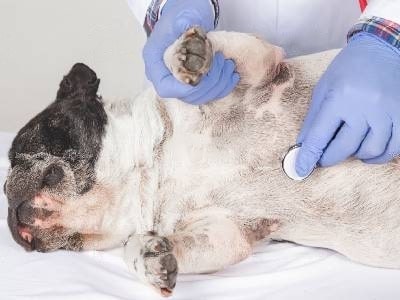Normally, fruits are healthy for dogs. They are a good addition to their daily diet and have ample benefits. Still, many fruits are toxic for dogs. So, in this article, we’ll try to provide an answer to the question – Can dogs eat plums? Plum being healthy and nutritious fruit serves great benefits to dog but is it same for the dogs too?

Can Dogs Eat Plums?
No, dogs cannot eat plums. While plums are toxic for dogs[1], if they have eaten plum flesh, there is nothing to worry about. So, it seems like flesh plum is safe for the dog and may also provide some healthy vitamins.

However, the remaining fruit includes the stem, pit, leaves, and plant compounds. These all are toxic for the dog. So, what happens if they do eat plums? If this happens there is a risk of cyanide poisoning. You’ll have to rush to the nearest emergency room instantly as cyanide poisoning can lead to kidney failure and in some cases even death.
Also, if you have a small dog breed, then even a small amount of ingestion will cause cyanide poisoning.
Note: Cyanide poisoning is also known as plum poisoning
Cause of Plum Poisoning in Dogs
When a dog ingests plum plants, the hydrogen cyanide present stops cell respiration. The toxin is released from cyanogenic glycosides after the dog chews the plum. Cyanogen is understood as one of the fastest and most natural toxins, amygdalin is a cyanohydrin that is responsible for slowly releasing cyanide into the bloodstream.
Signs of Plum Poisoning
If your dog does have plum poisoning here are some of the symptoms you can look out for:
- Difficulty in breathing (Respiratory failure)
- There is redness around the mouth, especially on the gums and tongue
- Panting
- Trembling
- Dogs’ pupils are dilated
- Seizures
- Loss of balance
- Confusion or Discomfort
- Foaming near the mouth
The symptoms of plum poisoning set in quickly. If your dog has had a plum pit then, within an hour you’ll observe the signs and your dog’s health will start deteriorating instantly. Call your Vet, and take your dog to the nearest hospital for treatment, or take help from gov organizations such as Defra.
Vet Treatment & Recovery
Once the vet confirms the plum poisoning, they will start with the treatment after the laboratory tests are done. These tests done are – blood urea nitrogen (BUN), complete blood count (CBC), packed cell volume (PCV) urinalysis, and a serum biochemical profile for observing the elevated ammonia, and amino acids.

Vet Treatment
The main goal is to get rid of the cyanide and the toxins in dogs’ systems. The Vet will immediately start with the treatment as time is a significant factor while dealing with such emergencies.
Detoxification
In this treatment, either methylene blue or sodium nitrite will be given via intravenous (IV), this will help in methemoglobin formation in the blood. This will get mixed with the cyanide and form cyanomethemoglobin, removing the cyanide from the blood.
If this doesn’t work out vet may consider thiosulfate, which facilitates the formation of rhodanese-catalyzed thiocyanide and frees the body of the cyanide.
Observation
In case of plum poisoning, the dog must get hospitalized. There your canine friend will remain under 24-hour observation to monitor the pet and treat any difficulties. During this period, the vet staff will continuously monitor the dog and keep providing oxygen, fluids, and other necessary care during the recovery.
Recovery
The dogs’ recovery relies on the consumption of plum pits. Also, the response to the treatment and the timeliness of the therapy will give you an idea of the recovery.
This treatment and recovery were specific to plum poisoning. There are a couple of other issues that can cause some serious trouble for your canine friend.
Choking Hazard
Dogs may swallow plums and it can get ugly. The plum could easily get stuck in its oesophagus. These cause issues, especially in small dogs.
Plums contain pits that could get stuck in a dog’s throat, similar to how watermelon seeds can be a choking hazard for dogs if swallowed whole. Check out our article on can dogs eat watermelon seeds for more advice.
Intestinal Blockage
At times, dogs will swallow the plum pit, while this may not result in cyanide poisoning, it does increases the chances of intestinal blockage. The pit could get stuck in the digestive tract, and this blockage can be life-threatening. To resolve this issue of intestinal blockage, the dog may need surgery.
Plum Flesh is Safe
Despite the risks, as mentioned earlier, eating plum flesh and skin in small amounts is safe for dogs. There are many benefits of eating plums for a dog. They can get vitamin K and potassium by eating the flesh plum. Also, the plum is considered a good source of Vitamin C and antioxidants.
In addition, an occasional treat of flesh plum helps control blood sugar levels. However, it is crucial that you give this treat in a moderate proportion as plum flesh retains high sugar, and too much sugar can result in obesity. The water proportion being high is useful in keeping them hydrated.
Now, let’s see some specific ways you can feed the plum to your dog without causing any severe issues.
Tips On Feeding Dog Plums With Caution

We saw the cause of plum poisoning, and how it can also be a choking hazard for the dog. Here are some simple tips to consider before you feed your dog the plum.
#1 Wash the fruit
#2 Remove the pit of the plum and dispose of it
#3 Slice the plum into pieces to avoid choking
Also, make sure that you don’t serve dry plum to the dog. Dry plum/prune contains higher sugar content, and while it may not be toxic, it causes diarrhoea and upsets the stomach of the dog. To avoid the slightest complications, you should consult with the Vet before you plan to give the plum treat to your canine friend.
But, how often can you give the plum treat? – like all treats are given in moderation or as a snack, you should give your canine friend a few slices of plum, once or twice a week or a month.
Plum Alternative for Dogs
If you are looking for some plum alternatives which can offer similar nutritional benefits then here are a few fruits you can consider as a treat:
- Kiwi– this healthy green fruit retains almost the same quantity of vitamin K as a plum. This quantity is approximately 4 times more than a fresh plum.
- Banana– contains twice as much potassium as plums. They also help with dogs’ cardiovascular, muscular, and nervous systems.
- Oranges– this citrus food is safe for your canine friend. Oranges add an extra dose of vitamin C to your dog’s diet. Although Vitamin C is not quite necessary for dogs, the additional amount supports the immune system of old or sick dogs.
- Berries– are a good source of antioxidants to support the pets’ immune system. Strawberries, blackberries, blueberries, and raspberries are dog-friendly treats.
- Pumpkin– is high fibre and very effective for dogs to improve their digestive system.
While feeding any of these fruits, make sure you remove the skin of the fruit. Berries are an exception, you can feed them without removing the skin. However, introducing these fruits in bulk can cause gastrointestinal issues for the dog.
Some dog always consider giving broad beans to their pup as a treat. It is always good to ask your vet before feeding any new foods like, “can dogs eat broad beans?”.
FAQs
Are plums poisonous to dogs?
If dogs end up chewing the plum pit, then the presence of the cyanide will make the dog face plum poisoning. Plums can also cause choking and impact dogs’ overall health.
Can dogs eat plums or prune?
A couple of slices of plum or a single prune, probably, will not have any significant impact on the dog. However, both retain a high proportion of sugar content and fibre which can unsettle the dogs’ digestive system. So, it’s good to avoid any of these treats.
Can Plums kill Dogs?
Dogs eat plums and then risk facing critical health conditions. If dogs accidentally chew down the plum pits they are quickly going to get plum poisoning and if the treatment doesn’t go through or doesn’t receive any treatment then they may probably die.
Can Dogs Eat Plum?- Final Take
So, Can Dogs Eat Plums? No, Plums for dogs are not a good idea. There are ample reasons to avoid feeding plums. But, if you have to, you’ll have to stay alert and make sure you don’t provide them in excessive quantity.
However, if you wish to offer them the occasional plum treat, wash the plum, slice them into pieces and remove the pit, the plum treat is ready for the dog.
While plums are not recommended, other fruits and vegetables like asparagus can make healthy treats for dogs when given in moderation. So be sure to research whether is asparagus good for dogs before feeding it to them
Reference:
- Saylor, A. (2023a, July 5). Can dogs eat plums? PetMD.



